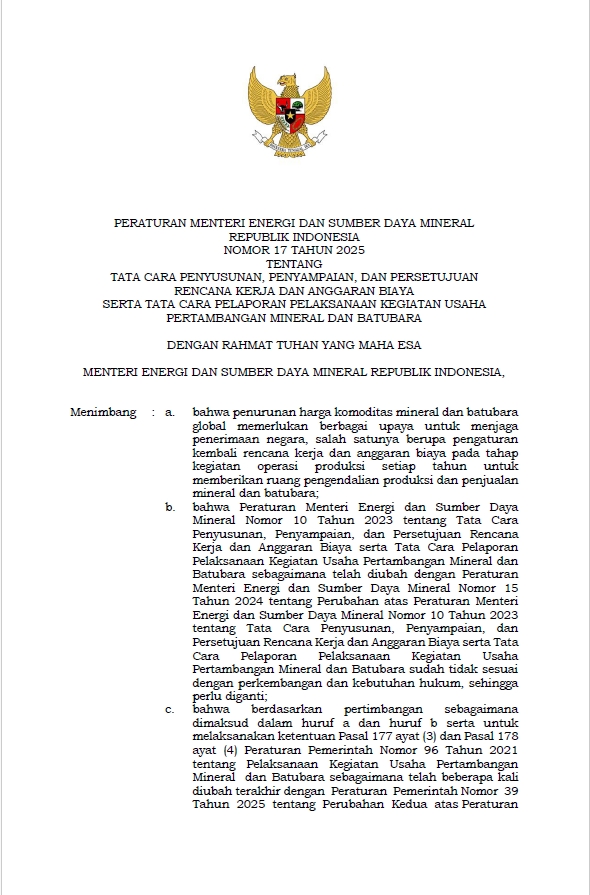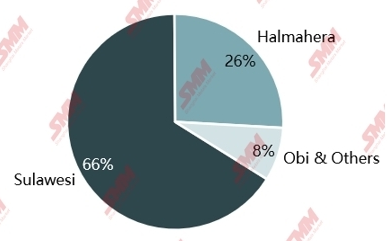






Introduction
On October 3rd 2025, Regulation of the Minister of Energy and Mineral Resources Number 17 of 2025 on Procedures for the Preparation, Submission, and Approval of Work Plans and Budgets, and for the Reporting of the Implementation of Mineral and Coal Mining Activities in 2026 has officially released. This regulation is revising the initial three-year period back to annual period in 2026, although several IUP has received 2026's quota from the previous approvals in 2024 and 2025, annuling the initial quota that has been approved.
"The revision of the RKAB here serves as one of the measures to maintain state revenue affected by the decline in mineral and coal commodity prices"

I. Overview of New RKAB Update:
1. General Procedures
According to the Part Two of Procedures for Preparing Work Plans and Budgets, Article 3 stipulates that:
The preparation of the RKAB for the Exploration stage or the RKAB for the Production Operation stage by holders of IUP at the Exploration stage, holders of IUPK at the Exploration stage, holders of IUP at the Production Operation stage, holders of IUPK at the Production Operation stage, or holders of IUPK as a Continuation of Contract/Agreement Operations as referred to in Article 2 paragraph (1), shall consist of a plan for Mineral and Coal Mining business activities for one (1) year as a guideline for implementing Mineral and Coal Mining business activities.
2. Timeline of Submission
Meanwhile, Article 4 of “Procedures for Submitting the Work Plan and Budget” primarily outlines the timeline for submitting the RKAB.
3. Documents Required
Exploration Stage RKAB Requirements:
Production Operation Stage RKAB Requirements:
Article 6 outlines the evaluation and approval process for RKAB submissions. The Minister or Governor must evaluate applications for Exploration or Production stages, including contract continuations, within five working days, either approving them or requesting corrections. License holders have two working days to resubmit corrections, with up to three rounds allowed. A final decision to approve or reject must be made within eight working days, and if no decision is issued within this period, the RKAB is automatically approved through the system."
Additional Approvals Required:
Even after RKAB approval, license holders must still obtain:
4. RKAB Amendment/Revision
Article 11 regulates the amendment of the RKAB, allowing license holders of IUP or IUPK in either the Exploration or Production Operation stage, including Continuation of Contract/Agreement Operations, to submit one amendment request per year. Such requests can only be made after the submission of periodic reports up to the second quarter or no later than July 31 of the current year.
III. SMM's Analysis: Current RKAB’s Progress in 2025
Structure of Indonesia’s Nickel RKAB Quota Distribution by Island:

Quota Distribution (SMM's Model):
Total Distribution: >315 million
From the total RKAB of over 315 million tonnes, the total production until September is predicted to not reached 200 million tonnes. It is expected that there will be “oversupply” in terms of the quota provided to the market. However, due to unpredictable rainy season, forestry task’s force and any other regulation issues, the current supply to the market does not match the quota provided.
On the current perspective, we observe that nickel ore market will remain be oversupplied in terms of quota. However, the ore supplied to the market is always constrained by the miners’ incapability from unpredictable rainy season, royalty hikes and other stringent regulations that held back the sales of nickel ore. Overall, SMM predicts that the nickel ore production will be relatively lower than the RKAB quota for 2025. In terms of price, current mainstream premium of high-grade nickel ore (saprolite) is traded at $25-$26 in addition to the HPM, and for the low-grade nickel ore (limonite) for 1.3% is traded at $24. Premium for saprolite has increased for approximately $1-$2, and limonite has remained stable from its drop of $2 back from two months ago. The reason is that the demand for saprolite ore from RKEF smelters has slightly increased, coupled with stricter regulations and warnings issued to mining companies. However, limonite demand has not risen significantly, as a large portion of the RKAB for limonite was only released in Q3.
IV. SMM's Analysis: RKAB in 2026 Outlook
Looking forward, it is expected that ESDM will continue to imply strict regulations in terms of new RKAB Approval since it is being reset for all companies. According to SMM's calculation, the nickel ore demand in Indonesia is going to reach 280 million wmt, which is still relatively lower than the RKAB Approved. However, due to some incapability of miners to produce ore during this situation, and while some large IUP mining companies have utilized much of their production, the market supply wasn't that significantly abundant either. It is expected that stockpiling activity will start in Q4 from the smelters to anticipate the supply hindrance in Q1 2026. Therefore, the price of nickel ore has an upward potential/stable There will be indications that the process of RKAB Approval for all minerals might incur several delay, which potentially could tighten the supply of nickel ore dynamics in the first quarter of 2026.
For queries, please contact Lemon Zhao at lemonzhao@smm.cn
For more information on how to access our research reports, please email service.en@smm.cn